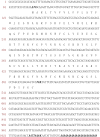Molecular Characterization of a Lysozyme Gene and Its Altered Expression Profile in Crowded Beet Webworm (Loxostege sticticalis)
- PMID: 27575006
- PMCID: PMC5019359
- DOI: 10.1371/journal.pone.0161384
Molecular Characterization of a Lysozyme Gene and Its Altered Expression Profile in Crowded Beet Webworm (Loxostege sticticalis)
Abstract
There is growing evidence that insects living in high-density populations exhibit an increase in immune function to counter a higher risk of disease. This phenomenon, known as density-dependent prophylaxis, has been experimentally tested in a number of insect species. Although density-dependent prophylaxis is especially prevalent in insects exhibiting density-dependent phase polyphenism, the molecular mechanism remains unclear. Our previous study demonstrated that the antibacterial activity of lysozyme is important for this process in the beet webworm Loxostege sticticalis. In this study, a lysozyme cDNA from L. sticticalis was cloned and characterized. The full-length cDNA is 1078 bp long and contains an open reading frame of 426 bp that encodes 142 amino acids. The deduced protein possesses structural characteristics of a typical c-type lysozyme and clusters with c-type lysozymes from other Lepidoptera. LsLysozyme was found to be expressed throughout all developmental stages, showing the highest level in pupae. LsLysozyme was also highly expressed in the midgut and fat body. Elevated LsLysozyme expression was observed in L. sticticalis larvae infected by Beauveria bassiana and in larvae reared under crowding conditions. In addition, the expression level of LsLysozyme in infected larvae reared at a density of 10 larvae per jar was significantly higher compared to those reared at a density of l or 30 larvae per jar. These results suggest that larval crowding affects the gene expression profile of this lysozyme. This study provides additional insight into the expression of an immune-associated lysozyme gene and helps us to better understand the immune response of L. sticticalis under crowding conditions.
Conflict of interest statement
The authors have declared that no competing interests exist.
Figures





Similar articles
-
Identification and molecular characterization of a chitin-binding protein from the beet webworm, Loxostege sticticalis L.Int J Mol Sci. 2014 Oct 22;15(10):19147-61. doi: 10.3390/ijms151019147. Int J Mol Sci. 2014. PMID: 25340980 Free PMC article.
-
Immunological regulation by a β-adrenergic-like octopamine receptor gene in crowded larvae of the oriental Armyworm, Mythmina separata.Dev Comp Immunol. 2020 Dec;113:103802. doi: 10.1016/j.dci.2020.103802. Epub 2020 Jul 24. Dev Comp Immunol. 2020. PMID: 32712170
-
Molecular characterization of a c-type lysozyme from the desert locust, Schistocerca gregaria (Orthoptera: Acrididae).Dev Comp Immunol. 2016 Aug;61:60-9. doi: 10.1016/j.dci.2016.03.018. Epub 2016 Mar 18. Dev Comp Immunol. 2016. PMID: 26997372
-
Effects of larval density on flight potential of the beet webworm, Loxostege sticticalis (Lepidoptera: Pyralidae).Environ Entomol. 2010 Oct;39(5):1579-85. doi: 10.1603/EN09314. Environ Entomol. 2010. PMID: 22546455
-
Insect lysozymes.EXS. 1996;75:87-102. doi: 10.1007/978-3-0348-9225-4_6. EXS. 1996. PMID: 8765296 Review.
Cited by
-
Functional Characterization of Pheromone Receptors in the Beet Webworm, Loxostege sticticalis (Lepidoptera: Pyralidae).Insects. 2023 Jun 27;14(7):584. doi: 10.3390/insects14070584. Insects. 2023. PMID: 37504590 Free PMC article.
-
Effects of Larval Density on Plutella xylostella Resistance to Granulosis Virus.Insects. 2020 Dec 2;11(12):857. doi: 10.3390/insects11120857. Insects. 2020. PMID: 33276568 Free PMC article.
-
A chromosome-level genome assembly of beet webworm, Loxostege sticticalis Linnaeus (Lepidoptera: Pyralidae).Sci Data. 2025 May 26;12(1):869. doi: 10.1038/s41597-025-04371-8. Sci Data. 2025. PMID: 40419506 Free PMC article.
References
-
- Imler JK, Bulet P. Antimicrobial peptides and activation of immune response in Drosophila: structures, activities and gene regulation. Chemical Immunology and Allergy. 2005; 86: 1–21. - PubMed
-
- Powning RF, Davidson WJ. Studies on insect bacteriolytic enzymes-II. Some physical and enzymatic properties of lysozyme from haemolymph of Galleria mellonella. Comparative Biochemistry and Physiology Part B: Comparative Biochemistry. 1976; 55: 221–228. - PubMed
-
- Jolles P, Jolles J. What’s new in lysozyme research? Always a model system, today as yesterday. Molecular and Cellular Biochemistry. 1984; 63: 165–189. - PubMed
-
- Ren Q, Zhao XF, Wang JX. Molecular characterization and expression analysis of a chicken-type lysozyme gene from housefly (Musca domestica). Journal Genetics and Genomics. 2009; 36: 7–16. - PubMed
MeSH terms
Substances
LinkOut - more resources
Full Text Sources
Other Literature Sources

